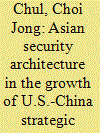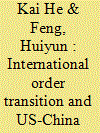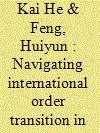| Srl | Item |
| 1 |
ID:
108530


|
|
|
|
|
| Publication |
2011.
|
| Summary/Abstract |
Recognizing that the broader structure of East Asia's regional order is going to
change, this paper assumes that there are three major factors to drive and facilitate
the East Asian order: (1) An existing security architecture comprised of various
bilateral and multilateral mechanisms; (2) the role of America in adjusting the current
security multilateralism to lead to it remaining cooperative and/or competitive; and
(3) the bilateral relationship of the two powers, the United States and China.
The paper argues that East Asian order has been and will be determined by the
changing state of Sino-U.S. relations. Then it explores what relationship the United
States and China engage in and where it is directed. The next section discusses what
effect the Sino-U.S. relationship has on the security order in East Asia focusing on
the major multilateral security arrangements as seen in Figure 1. To do this, the
two distinct multilateral security mechanisms, the U.S.-Japan-Australia Trilateral
Strategic Dialogue (TSD) and the Shanghai Cooperation Organization (SCO), will be
analyzed. Additionally, as a bridge between the United States and China for security
cooperation, the Korea-China-Japan Tripartite Cooperation Dialogue (TCD) will be
explored. The future of both Sino-U.S. relations and its relations with the East Asian
security order are dealt with in the conclusion.
|
|
|
|
|
|
|
|
|
|
|
|
|
|
|
|
| 2 |
ID:
190662


|
|
|
|
|
| Summary/Abstract |
The world is changing, and the liberal international order (LIO) is at stake. Scholars and pundits hold different views on whether and how an order transition will take place. We argue that the divergent arguments around LIO are rooted in contested conceptualizations of what an international order is as well as the untheorized measure of what counts as a ‘transition’ of international order. We propose a synthesized and deductive approach to defining international order with three pillars: power, institutions, and norms. We argue that a significant order transition will take place when at least two pillars of the order are fundamentally challenged and eventually changed. Applying this deductive, three-pillar conceptual framework of international order, we preliminarily examine how US-China competition has impacted the current LIO in the Indo Pacific. We conclude that the multi-pillar feature of the international order technically strengthens the sustainability and resilience of the current LIO. Even though China’s rise might change the power distribution in the system—the power pillar of the order, the mere power shift between China and the United States will not lead to a significant order transition if the other two pillars of the order remain intact.
|
|
|
|
|
|
|
|
|
|
|
|
|
|
|
|
| 3 |
ID:
190661


|
|
|
|
|
| Summary/Abstract |
The world is in crisis. The Covid pandemic and the ongoing Russia-Ukraine war signify a potential order transition in the international system. The Indo Pacific is at the center of gravity of great power competition between the US and China. How have policy elites in the region perceived the potential order transition against the background of US-China strategic competition? How have states, including both great and secondary powers, chosen different strategies to cope with security and economic turbulence in the Indo Pacific? This special issue intends to shed some light on these questions by critically examining the diverse perceptions and policy choices of the United States, China, South Korea, India, Japan, Indonesia, and the UK during the period of potential order transition in the Indo Pacific. It provides an academic platform for scholars to engage in this ‘order transition’ topic from different theoretical perspectives as well as from respective national angles in the Indo Pacific. It suggests that the complexity of the international order itself has made the ‘order transition’ more complicated and difficult than before. It is the best of times, it is the worst of times, and it is the most challenging time for state leaders and scholars alike.
|
|
|
|
|
|
|
|
|
|
|
|
|
|
|
|